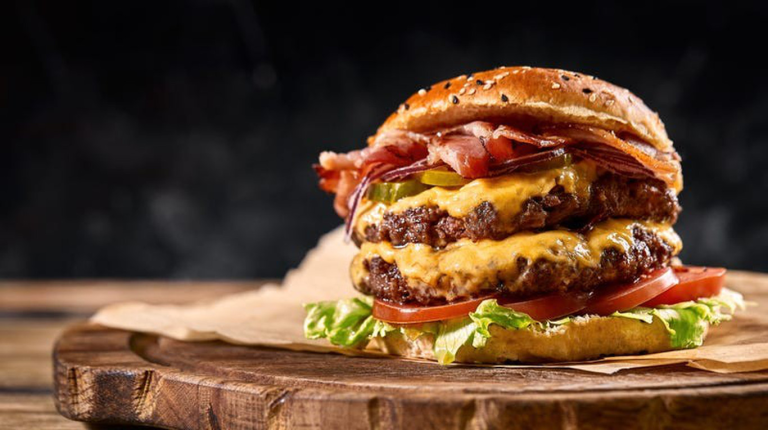Not Just Beef Is Featured in the Juiciest Burgers

Glutamates, which are abundant in mushrooms, balance the nucleotides in beef to produce a distinctly umami flavor. They’re brimming with water as well. Nevertheless, my very first taste of a mixed burger—which combines ground beef and chopped white mushrooms—was revolutionary. The burger was bursting with flavorful, rich liquids and was by far the most tender, succulent, and juicy I’ve ever had. Moreover, it had the same level of meatiness and satisfaction as any burger made entirely of beef.
It’s terrific news: Blended burgers are a way to eat less red meat without feeling like you’re making sacrifices. In fact, you’ll be doing a whole lot of good.
Stretching beef with mushrooms—whether for the nutritional perks (lower saturated fat); budget goals (everyday white mushrooms cost about half as much per pound as ground beef); or environmental impact (mushroom production is highly sustainable, requiring minimal growing space and water)—is the answer to getting a burger fix without resorting to smaller patties or enjoying them less often.
The Meat of the Matter
There’s no prescribed method for blended burgers, though the mushrooms are typically parcooked in some way before they’re mixed with the beef and some sources say that the blend should contain at least 1 part mushrooms to 4 parts beef. Wanting to include as many mushrooms as possible, I doubled the mushroom part of the ratio, selecting 8 ounces of ordinary white mushrooms and 1 pound of 80 percent lean ground beef—the same kind I’d select for an all-beef burger. I needed the smaller amount of meat to contribute as much hearty flavor as possible, and lean beef just isn’t as tasty. That’s because much of the meat’s flavor resides in its fat.
I hand-chopped the mushrooms as finely as possible so that they would disappear into the blend and then sautéed and cooled them before folding them and their juices into the beef. I handled the mixture gently, worried that an aggressive touch would toughen the patties. (We know that the more ground meat is worked, the more its myosin—a protein that tightens up upon cooking—develops.)
Science: Burgers So Juicy, You Need to “Overcook” Them

A medium-rare, 100 percent beef burger is succulent because the meat has been cooked to only 125 degrees, so its fibers contract just slightly, squeezing out a small amount of juice. Cooked to a higher temperature, the fibers will tighten up more, sending floods of juice into the skillet. Our blended burgers are different: At 125 degrees, they’re—get this—too juicy. For the best texture, we cook them to at least 135 or even as high as 165 degrees.
Although the beef in blended burgers will shed extra juices at these higher temperatures, the mushrooms, which we precook in the microwave, will not. Mushrooms release some of their water when they’re initially heated, but they still hold on to abundant moisture. When you take a bite of a blended burger, some of their liquid is released, and with continued chewing, even more is wrung out, providing a supremely juicy sensation.
To compare the moisture retention of all-beef and blended burgers, we recorded their pre- and post-cooking weights when cooked to 120, 140, and 160 degrees. In every instance, the all-beef burgers shed more liquid.
After shaping the blend into four big patties and seasoning each with salt and pepper, I seared them in a bit of oil in a skillet until they were deeply browned on the outside and registered about 125 degrees inside. They tasted wonderful: The earthiness of the mushrooms was subtly apparent, but the meatiness of the beef dominated.
What I didn’t expect was how tender—and wet— the burgers would be: They nearly floated in puddles of liquid in the skillet. I was certain that with a little tinkering, I could make the method more efficient, use even more mushrooms without sparing beefiness, and firm up and dry out the patties.
To Mince or Puree, Put Your Finger on the Pulse (Button)

If you place large ingredients such as whole mushrooms in a food processor, hit the “on” button, and let it rip, you’ll have to frequently stop to scrape the sides of the workbowl to nudge the ingredients toward the bottom. That’s because the fast-spinning blades don’t allow big items to fall between them, where they can be cut. Instead, they bounce around atop the whizzing blades. Here’s what to do instead: Start by hitting the pulse button for 1- to 2-second intervals to allow large pieces to fall to the bottom of the bowl during the pauses. As the pieces become smaller, you can pulse faster and faster, finally graduating to leaving the processor steadily on to produce a fine mince or puree.
Making Room for Mushrooms
The whole point of blended burgers is to bulk meat up with mushrooms, so my next move was to further increase the amount of mushrooms to 12 ounces, bringing the mushroom-beef ratio to 3:4. I also switched from a cutting board and knife to a food processor to allow me to rapidly grind the fungi to a thick paste. Some form of parcooking was essential to free the mushrooms of their ample moisture, but rather than relying on the stove, where lots of tending is involved, I popped them into the microwave. After just 3 minutes and a quick stir partway through, the mushroom paste started to boil in its own liquid, so I pulled it out. My next step was crucial: straining off excess juices. Draining away 1/2 cup of mushroom liquid ensured that the burgers cooked up moist but not soggy.
Given the overly tender texture of my first round of burgers, I mixed this batch much more assertively than the last. But the extra stirring didn’t firm them up enough. In fact, the patties were still so soft (they verged on mushy) that my colleagues asked if there was anything I could do to make them a little sturdier.
Science: The Role of Myosin in Mushroom-Centric Burgers

When meat is ground and vigorously mixed, its sticky protein called myosin dissolves out of the muscle, forming a gel that gives ground meat a springy texture. In 100 percent beef burgers, excess myosin development will make for tough patties, but in a blended burger that’s packed with mushrooms, myosin development is an asset.
That’s because the sturdy network helps to hold all of the tiny mushroom bits in place for a texture that’s tender yet firm.
To develop as much myosin as possible in our blended burgers, we work salt into the blend, rather than sprinkling it onto the shaped patties. Added this way, salt increases the solubility of myosin, drawing it out of the muscle so that it can bind the burger together. We also rough the mushroom–ground beef blend up in a food processor, since the vigorous whirring metal blade develops much more sticky myosin than mixing by hand.
Blending In
I identified a couple of ways to encourage even more myosin development and thus sturdier patties—both unthinkable if I were making all-beef burgers. First, since I’d already used the food processor to mince the mushrooms, I returned the cooked, cooled mushroom paste to the workbowl and used the fast-spinning blades to blend it with the beef, creating more myosin gel. Second, I added salt to the mushroom-beef blend rather than just seasoning the surface of the patties. This helped dissolve the myosin into a “glue” to bind the meat.
Finally, cooking the patties to at least 135 degrees was key to a tender-firm texture with just the right level of juiciness. (For those who prefer their burgers well-done, I’m pleased to report that even at 165 degrees, the patties were still deliciously succulent and tender.)
These blended burgers are thick, hearty, meaty, and juicy—pretty impressive for patties that contain only 4 ounces of beef apiece. And just like all-beef burgers, they’re entirely customizable. (See the delicious results of my topping brainstorm session below.)
When I look to the future, it’s bright—and full of fungi-forward burgers.



